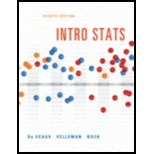
Concept explainers
Parameters and hypotheses For each of the following situations, define the parameter (proportion or mean) and write the null and alternative hypotheses in terms of parameter values. Example: We want to know if the proportion of up days in the stock market is 50%. Answer: Let p = the proportion of up days. H0: p = 0.5 vs. HA: p ≠ 0.5.
- a) A casino wants to know if their slot machine really delivers the 1 in 100 win rate that it claims.
- b) Last year, customers spent an average of $35.32 per visit to the company’s website. Based on a random sample of purchases this year, the company wants to know if the mean this year has changed.
- c) A pharmaceutical company wonders if their new drug has a cure rate different from the 30% reported by the placebo.
- d) A bank wants to know if the percentage of customers using their website has changed from the 40% that used it before their system crashed last week.
a.
Define the parameter.
State the null and alternative hypotheses.
Answer to Problem 1E
The parameter is p, which is defined as the probability of winning on a slot machine.
The test hypotheses are given below:
Null hypothesis:
Alternative hypothesis:
Explanation of Solution
Justification:
Parameter:
Any statistical measure based on all units in the population is called Parameter.
The study based on the casino wants to identify the probability of winning on a slot machine.
In the given situation, the parameter of interest is p, which is defined as the probability of winning on a slot machine.
Hypotheses:
The test hypotheses are given below:
Null hypothesis:
That is, the proportion of winning on a slot machine is 0.01
Alternative hypothesis:
That is, the proportion of winning on a slot machine is different from 0.01.
b.
Define the parameter.
State null and alternative hypothesis.
Answer to Problem 1E
The parameter is
The test hypotheses are:
Null hypothesis:
Alternative hypothesis:
Explanation of Solution
Justification:
The data represents the amount spent on purchase by the customer.
In the given situation, the parameter of interest is
The test hypotheses are given below:
Null hypothesis:
That is, the average amount spent on purchase per customer in a year is $35.32.
Alternative hypothesis:
That is, the average amount spent on purchase per customer in a year is different from $35.32.
c.
Define the parameter.
State null and alternative hypothesis.
Answer to Problem 1E
The parameter is p, which is defined as the percentage of patients cured by new drug.
The test hypotheses are given below:
Null hypothesis:
Alternative hypothesis:
Explanation of Solution
Justification:
The data represents the effect of new drug on patients by pharmaceutical company.
In the given situation, the parameter of interest is p, which is defined as the percentage of patients cured by new drug.
The test hypotheses are given below:
Null hypothesis:
That is, the percentage of patients cured by new drug is 0.30.
Alternative hypothesis:
That is, the percentage of patients cured by new drug is different from 0.30.
d.
Define the parameter.
State null and alternative hypothesis.
Answer to Problem 1E
The parameter is p, which is defined as the percentage of Customers using the website of bank.
The test hypotheses are given below:
Null hypothesis:
Alternative hypothesis:
Explanation of Solution
Justification:
A bank wants to identify the proportion of customers using the bank’s website.
In the given situation, the parameter of interest is p, which is defined as the percentage of Customers using the website of bank.
The test hypotheses are given below:
Null hypothesis:
That is, the percentage of Customers using the website of bank is 40%.
Alternative hypothesis:
That is, the percentage of Customers using the website of bank is different from 40%.
Want to see more full solutions like this?
Chapter 19 Solutions
Intro Stats
- A company found that the daily sales revenue of its flagship product follows a normal distribution with a mean of $4500 and a standard deviation of $450. The company defines a "high-sales day" that is, any day with sales exceeding $4800. please provide a step by step on how to get the answers in excel Q: What percentage of days can the company expect to have "high-sales days" or sales greater than $4800? Q: What is the sales revenue threshold for the bottom 10% of days? (please note that 10% refers to the probability/area under bell curve towards the lower tail of bell curve) Provide answers in the yellow cellsarrow_forwardFind the critical value for a left-tailed test using the F distribution with a 0.025, degrees of freedom in the numerator=12, and degrees of freedom in the denominator = 50. A portion of the table of critical values of the F-distribution is provided. Click the icon to view the partial table of critical values of the F-distribution. What is the critical value? (Round to two decimal places as needed.)arrow_forwardA retail store manager claims that the average daily sales of the store are $1,500. You aim to test whether the actual average daily sales differ significantly from this claimed value. You can provide your answer by inserting a text box and the answer must include: Null hypothesis, Alternative hypothesis, Show answer (output table/summary table), and Conclusion based on the P value. Showing the calculation is a must. If calculation is missing,so please provide a step by step on the answers Numerical answers in the yellow cellsarrow_forward
 Glencoe Algebra 1, Student Edition, 9780079039897...AlgebraISBN:9780079039897Author:CarterPublisher:McGraw Hill
Glencoe Algebra 1, Student Edition, 9780079039897...AlgebraISBN:9780079039897Author:CarterPublisher:McGraw Hill Big Ideas Math A Bridge To Success Algebra 1: Stu...AlgebraISBN:9781680331141Author:HOUGHTON MIFFLIN HARCOURTPublisher:Houghton Mifflin Harcourt
Big Ideas Math A Bridge To Success Algebra 1: Stu...AlgebraISBN:9781680331141Author:HOUGHTON MIFFLIN HARCOURTPublisher:Houghton Mifflin Harcourt Holt Mcdougal Larson Pre-algebra: Student Edition...AlgebraISBN:9780547587776Author:HOLT MCDOUGALPublisher:HOLT MCDOUGAL
Holt Mcdougal Larson Pre-algebra: Student Edition...AlgebraISBN:9780547587776Author:HOLT MCDOUGALPublisher:HOLT MCDOUGAL



